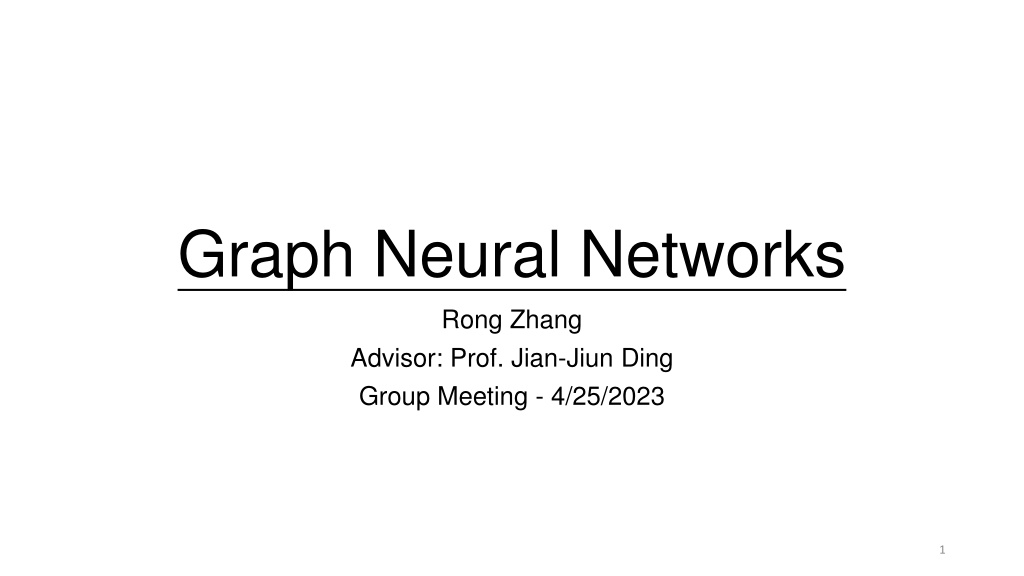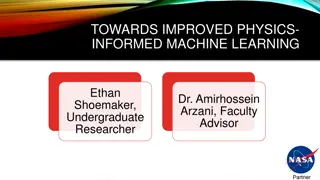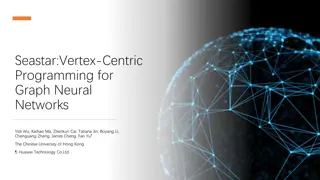Graph Neural Networks
Graph Neural Networks (GNNs) are a versatile form of neural networks that encompass various network architectures like NNs, CNNs, and RNNs, as well as unsupervised learning models such as RBM and DBNs. They find applications in diverse fields such as object detection, machine translation, and drug discovery by representing data in graph structures. Message Passing Neural Networks, a GNN variant, are used in quantum chemistry analysis, while complex frameworks like Graph-ResNet and Moment-Embedded Network (MoNet) further enhance feature extraction capabilities. The evolution and significance of GNNs in modern machine learning are highlighted in this research overview.
Download Presentation

Please find below an Image/Link to download the presentation.
The content on the website is provided AS IS for your information and personal use only. It may not be sold, licensed, or shared on other websites without obtaining consent from the author. Download presentation by click this link. If you encounter any issues during the download, it is possible that the publisher has removed the file from their server.
E N D
Presentation Transcript
Graph Neural Networks Rong Zhang Advisor: Prof. Jian-Jiun Ding Group Meeting - 4/25/2023 1
Outline Introduction 2
Introduction (1/5) Graph Neural Networks (GNNs) is general form of most neural networks such as NNs, CNNs or RNNs, even unsupervised learning like RBM and DBNs. Supervised Unsupervised GNNs DBNs and RBM DNNs Fig. relations between GNNs and other networks. 1: Illustration of RNNs CNNs AE SNNs GAN 3 Source: Self-made
Introduction (2/5) Many machine learning tasks such as object detection [1], [2], machine translation [3], [4], and speech recognition [5], which once heavily relied on handcrafted feature engineering. There is an increasing number of applications where data are represented in the form of graphs. [1] J. Redmon, S. Divvala, R. Girshick, and A. Farhadi, You only look once: Unified, real-time object detection, in Proc. of CVPR, 2016, pp. 779 788. [2] S. Ren, K. He, R. Girshick, and J. Sun, Faster r-cnn: Towards realtime object detection with region proposal networks, in Proc. of NIPS, 2015, pp. 91 99. [3] M.-T. Luong, H. Pham, and C. D. Manning, Effective approaches to attention-based neural machine translation, in Proc. of EMNLP, 2015, pp. 1412 1421. [4] Y. Wu, M. Schuster, Z. Chen, Q. V. Le, M. Norouzi, W. Macherey, M. Krikun, Y. Cao, Q. Gao, K. Macherey et al., Google s neural machine translation system: Bridging the gap between human and machine translation, arXiv preprint arXiv:1609.08144, 2016. [5] G. Hinton, L. Deng, D. Yu, G. E. Dahl, A.-r. Mohamed, N. Jaitly, A. Senior, V. Vanhoucke, P. Nguyen, T. N. Sainath et al., Deep neural networks for acoustic modeling in speech recognition: The shared views of four research groups, IEEE Signal processing magazine, vol. 29, no. 6, pp. 82 97, 2012. 4
Introduction (3/5) In chemistry, molecules [6] are modeled as graphs, and their bioactivity needs to be identified for drug discovery [7]. In a citation network [8], papers are linked to each other via citation ships and they need to be categorized into different groups. [6] Duvenaud, David K., et al. "Convolutional networks on graphs for learning molecular fingerprints." Advances in neural information processing systems 28 (2015). [7] Nguyen, Thin, et al. "GraphDTA: predicting drug target binding affinity with graph neural networks." Bioinformatics 37.8 (2021): 1140-1147. [8] Shchur, Oleksandr, et al. "Pitfalls of graph neural network evaluation." arXiv preprint arXiv:1811.05868 (2018). 5
Introduction (4/5) Message Passing Neural Networks [9], a variant of Graph Neural Networks, apply on quantum chemistry analysis and its application. Further complex framework, such as Graph-ResNet [10], can distillate certain features from images. Moment-Embedded Network embed multiple mixture models. (MoNet) [11], can efficiently [9] Gilmer, Justin, et al. "Neural message passing for quantum chemistry." International conference on machine learning. PMLR, 2017. [10] Guohao Li, Matthias Muller, Ali Thabet, Bernard Ghanem, DeepGCNs: Can GCNsGoasDeepasCNNs , ICCV, 2019. [11] Gou, Mengran, et al. "Monet: Moments embedding network." Proceedings of the IEEE Conference on Computer Vision and Pattern Recognition. 2018. 6
Introduction (5/5) Graph Neural Networks are also important components of Adversarial Attack [12] researching due to its characteristic of representing neural networks policies. Graph Neural Networks can be applied on neural networks topology optimization by its general form of neural networks [13]. [12] Z gner, Daniel, et al. "Adversarial attacks on graph neural networks: Perturbations and their patterns." ACM Transactions on Knowledge Discovery from Data (TKDD) 14.5 (2020): 1-31. [13] Xu, Kaidi, et al. "Topology attack and defense for graph neural networks: An optimization perspective." arXiv preprint arXiv:1906.04214 (2019). 7
Outline Introduction History 8
History (1/6) A classic problem, The Karate Club [14], is a benchmark of graph data evaluations. The network captures 34 members of a karate club, documenting links between pairs of members who interacted outside the club. Fig. 2: A network representation of social relationships among the 34 individuals in the karate club studied by Zachary [14]. [14] Zachary, Wayne W. "An information flow model for conflict and fission in small groups." Journal of anthropological research 33.4 (1977): 452-473. 9
History (2/6) In 1997, Sperduti et al. (1997) [14] first applied neural networks to directed acyclic graphs, which motivated early studies on GNNs. The first GNNs model being officially announced is in 2008 [15], which is comparably new compared with other classic models, such as CNNs (1980) and RNNs (1986). [14] A. Sperduti and A. Starita, Supervised neural networks for the classification of structures, IEEE Transactions on Neural Networks, vol. 8, no. 3, pp. 714 735, 1997. [15] Scarselli, Franco, et al. "The graph neural network model." IEEE transactions on neural networks 20.1 (2008): 61-80. 10
History (3/6) A brief timeline of neural network history. 1950 1960 1970 1980 1990 2000 2010 2020 * The Organization of Behavior by Do Hebb. 11
History (4/6) The Karate Club is a simple binary relation problem, by applying GNNs model, we can easily categorize two clubs. Fig. 3: The iteration of nodes by using GNNs model to categorize 34 individuals into two clubs from The Karate Club problem [16], [17]. [16] https://github.com/Steboss/learn_graph_ml [17] Scarselli, Franco, et al. "The graph neural network model." IEEE transactions on neural networks 20.1 (2008): 61-80. 12
History (5/6) Despite relations of nodes, GNNs also imply on embedding nodes data from regular vector domain. Graph neural networks vs. network embedding GNNs can address the network embedding problem through a graph autoencoder framework. Network embedding contains other non-deep learning methods such as matrix factorization [18], [19] and random walks [20]. [18] X. Shen, S. Pan, W. Liu, Y.-S. Ong, and Q.-S. Sun, Discrete network embedding, in Proc. of IJCAI, 2018, pp. 3549 3555. [19] H. Yang, S. Pan, P. Zhang, L. Chen, D. Lian, and C. Zhang, Binarized attributed network embedding, in Proc. of ICDM. IEEE, 2018. [20] B. Perozzi, R. Al-Rfou, and S. Skiena, Deepwalk: Online learning of social representations, in Proc. of KDD.ACM, 2014, pp. 701 710. 13
History (6/6) GNNs also can map non-Euclidean data to vector spaces spanned by standard basis [21], which is embedding network, a problem that GNNs handled in its early stage. Fig. 4:Asimple case of KL-divergence minimization [21]. [21] Shannon, Claude E. "A mathematical theory of communication." The Bell system technical journal 27.3 (1948): 379-423.. 14
Outline Introduction History Definition 15
Definition (1/4) TABLE I: Commonly used notations. Notations G V E N A K D ? ? ? ? ? ? Descriptions A graph. The set of nodes in a graph. The set of edges in a graph. The neighbors of a node. The graph adjacency matrix. Incident matrix. The degree matrix of A. The feature matrix of a graph. The node hidden feature matrix. 16
Definition (2/4) Directed Graph A directed graph is a graph with all edges directed from one node to another. A graph is undirected if and only if the adjacency matrix is symmetric. Spatial-Temporal Graph A spatial-temporal graph is an attributed graph where the node attributes change dynamically over time. Heterogeneous Graph [22] [22] Wang, Xiao, et al. "Heterogeneous graph attention network." The world wide web conference. 2019. 17
Definition (3/4) Dynamic graph Diffusion Convolutional Recurrent Neural Network (DCRNN) Hyper-graph Signed-graph Large-graph 18
Definition (4/4) Gradient analysis of graph ??????? ?? ??? ? ???? ? = ? ?,? ,? ?? ?? ??? ???????? ?? ??? ????? ? = ? ? ? ?????????? ??? ????? ? = ?,? ?,? ? , ?= ??? ? ?? ?? ??????? ?????????? ?? ???? : ?= ???? = ? ? , ? ??? ? ??????? ??????? ??????. ???? ??,?? ?????? ????? ??? ?????? ?? ? ???? ????????: ?: ? ?,? ? =1 2 ?~? ?? = ???, 2= ??? 2= ????. ???? ? ? ? 19
Outline Introduction History Definition Topology 20
Topology (1/8) Type of Graph operators TABLE II: Commonly used Modules of GNNs. Type Method Layer Spectral Convolution Spatial Convolution Attention Recurrent Convergence Recurrent Gate Skip Connection Direct Hierarchical Graph Convolution Graph Attention Graph Dense Graph LSTM Deep-GCN Sort-Pooling gPool Propagation Downsampling 21
Topology (2/8) Recurrent Graph Network In 2009, Scarselli et al. used RNNs to propagate directed acyclic graphs. Recurrent graph uses ?? as hidden node features related to other neighbor nodes. The state embedding is an s-dimension vector of node v and can be used to produce an output ? such as the distribution of the predicted node label. ??????? ?? ??? ???? ? ??? ??? ???? ??? ????? ??,? ?? ?? ???: = ? ??,??, ??,???,? ??? ? ??????? ???????? ??? ? ??????? ???? ???????. ? = ? ?,??,? ??? ? ??? ?? ??????????? ?? ???? ???????. 22
Topology (3/8) Spectral Graph Convolution ??????? ?? ??? ???? ??? ????????? ??? ? ?,? ?? ?? ?????? ???? ??????????? ? = 1? ? ? ? ,? ??? ??????? ??????? ?????????. ?? ? ?????,?? ??? ?????? ? ? ???????? ???????? ??: ? ? = ????? ?,? ??? ? ??????? ? ??? ?? ??????????, ?=0 ??? ? ?? ?????????? ?? ????????? ???? ???????? [23]. [23] Defferrard, Micha l, Xavier Bresson, and Pierre Vandergheynst. "Convolutional neural networks on graphs with fast localized spectral filtering." Advances in neural information processing systems 29 (2016). 23
Topology (4/8) Spectral Graph Convolution ?? 2017,???? ?? ??. 24 ???? ?? ???????? ? ? ???????? ??: 1 2?? 1 ????? ?? ??? ???? ???????? ??= ?? ? ?? ??? ?????? ? ????? ??: ?=0 ???????,?? ??? ???? ???????????: 2, ? ????? ? ?0? + ?1?? ??? 1 2?? 1 ? = ? ? ? + ? ? ??? ? ??????? ? ? ?????? ?????? ?? ???????? ?. 2 ?, [24] Kipf, Thomas N., and Max Welling. "Semi-supervised classification with graph convolutional networks." arXiv preprint arXiv:1609.02907 (2016). 24
Topology (5/8) Spatial Graph Convolution ????? ???? ? = ? ?,? ??? ? = ? ??? , ??= ??? ? ,?? ???: ?= ? ? ? ?????? ???????? ?? ??????? ???? ???????????. However, due to stability of gradient of convolution, a new propagation, Graph Attention [25] is announced to resolve the issues. ?????? ? = ???, [25] Veli kovi , Petar, et al. "Graph attention networks." arXiv preprint arXiv:1710.10903 (2017). 25
Topology (6/8) Graph Attention Graph convolution often has gradient vanishing/exploding problems due to its adjacency weighting mechanic, especially when we have substantial nodes. ??? ??????? ???? ???????????,?? ??? ? = ???,?? ????????? ?????????,?? ?????? ???????? ? ??: ? = ???????(? ??? ? ? ? ? ??????? ???????? ??? | ??????? ?? ??????????. ,? ??? ? ??????? ??????????, 26
Topology (7/8) Graph Attention Multi-head mechanic To further ensure the stability, Vaswani et al. [26] suggested multi-head attention to graph attention. ??????? ?? ??? ???? ????? ????? ? ????,? ?? ??? ???? ????????? ??????? ? ??? ?,?? ???: ? =1 ? ?=1 ? ?? ??????? ?? [26] Vaswani, Ashish, et al. "Attention is all you need." Advances in neural information processing systems 30 (2017). 27 Source: Self-made
Topology (8/8) Nodes definition: Given a feature tensor with dimension {?,?,?}, we have ? ? nodes with 1 ? feature vectors. 1 ? 1 ? ? ? 1 1 2 ? 1 ? ? ? ? ? ? Edges definition: Adjacency matrix is used to represent edges, hetero-graph in Deep-Graph-Learning library or cosine similarity presents edges by computing similarity of nodes. 28 Source: Self-made
Outline Introduction History Definition Topology Taxonomy 29
Taxonomy (1/10) Graph Neural Networks have various variants to implement on different fields, such as GNNs (Recurrent), GCNs (Spectral) and GATs (Spatial). By implementing different layers with features, we have various framework of graph neural network. 30
Taxonomy (2/10) Type Learning Framework GNN [27] Tree LSTM [28] Recurrent ESN [29] GGNN [30] Supervised GCN [31] GAT [32] MPNN [33] TABLE III: Types of GNNs. Mo-Net [34] Semi-Supervised GAE [35] Spatial or Spectral Adversarial ARGA [36] DGI [37] Unsupervised Info-graph [38] Multi-view [39] Evolutionary NAS [40] Reinforcement 31 Source: Self-made
Taxonomy (3/10) Other special type of GNNs Skip Connections Deep-GCN [41] Graph U-Net [42] Highway GCN [43] [41] Li, Guohao, et al. "Deepgcns: Can gcns go as deep as cnns?." Proceedings of the IEEE/CVF international conference on computer vision. 2019. [42] Gao, Hongyang, and Shuiwang Ji. "Graph u-nets." international conference on machine learning. PMLR, 2019. [43] Rahimi, Afshin, Trevor Cohn, and Timothy Baldwin. "Semi-supervised user geolocation via graph convolutional networks." arXiv preprint arXiv:1804.08049 (2018). 32
Taxonomy (4/10) Graph neural network (2008) ?1 ?2 ????? ????? 2 1 ????? ????? ?1 ?2 Fig. 5:Asimple illustration of GNN. 33 Source: Self-made
Taxonomy (5/10) Graph convolutional network (2016) ??? 1 2?? 1 1 ? ? + ? 2 2 1 ? ????? 1 ??? Fig. 6:Asimple illustration of GCN. 34 Source: Self-made
Taxonomy (6/10) Graph attention network (2017) ??? ????? ????? 1 ? ?|| ? 2 1 ? ????? 1 ??? Fig. 7:Asimple illustration of GAT. 35 Source: Self-made
Taxonomy (7/10) Graph Auto-Encoder (2016) ??? ??? 1 ? ? = ?(???) 2 1 ? ??? 1 Fig. 8:Asimple illustration of GAE. 36 Source: Self-made
Taxonomy (8/10) ?? Graph U-net (2019) ?? ?? ? ? ????? ?? ??? ??? ??? ? ??????? ?? ???????? ???? ???????? ??? ??? ???? ???????? ??????? ?? ???????? ??? ??? ? ? Fig. 9:Asimple illustration of Graph U-Net (left) and gPool (right). 37 Source: Self-made
Taxonomy (9/10) Deep-GCNs (2019) ???,512 ???,128 ???,128 ???,128 ???,128 ???,128 ???,128 ???,256 ???,256 ???,256 ???,256 ???,256 ???,256 ???,512 ???,512 ???????? ???????? ???????? ???,64 ???,64 ???,64 ????? 2? 4? 8? 16? Fig. 10:Asimple illustration of Res-GCN. 38 Source: Self-made
Taxonomy (10/10) Adversarial Regularized Graph Auto-encoder (2018) ??? ??? ? = ??? ?~?,? ???? ??? ?~?,? (????) + ???? Fig. 11:Asimple illustration ofARGA. 39 Source: Self-made
Outline Introduction History Definition Topology Taxonomy Applications 40
Applications (1/5) TABLE IV: Applications of GNNs. Application Graph Mining Physics Modeling Chemistry Biology Knowledge Graph Traffic Network Recommendation System References [44][45] [46][47][48] [49][50] [51][52][53] [54][55] [56][57] [58][59] 41
Applications (2/5) Image Classification by using ImageNet [60] Using Deep-GCNs to classify data from ImageNet. TABLE V: Comparison on ImageNet of GNNs and Res-Net. People (%) All (%) ??? ???????? ?????? ????? Res-Net 50 Deep-GCNs 92.3 97.5 75.1 82.5 ?????? ????? ??? 42 Source: Self-made
Applications (3/5) Semantic Segmentation by using COCO dataset [61] TABLE VI: Comparison on COCO segmentation of GNNs and Seg-Net. Animals (AP) 89.6 91.2 Trees (AP) 83.4 84.7 All (AP) 58.3 61.2 Seg-Net GNN [61] https://cocodataset.org/#home Source: Self-made 43
Applications (4/5) Object detection by using COCO dataset TABLE VII: Comparison on COCO object detection of GNNs and FPN. People (AP) 87.6 89.7 All (AP) 49.7 51.8 FPN [62] GNN [62] Lin, Tsung-Yi, et al. "Feature pyramid networks for object detection." Proceedings of the IEEE conference on computer vision and pattern recognition. 2017. 44 Source: Self-made
Applications (5/5) TABLE VIII: Some classic GNN models and their links. Model Code [63] [64] [65] [66] [67] [68] [69] Cheb-Net (2016) GAE (2016) GCN (2017) Graph-Sage (2017) GAT (2017) MPNNs (2017) Mo-Net (2017) 45 Source: Self-made
Outline Introduction History Definition Topology Taxonomy Applications Conclusion 46
Conclusion Now, you know one more tool to resolve problems. Is your problem suitable for GNNs? Or are your features suitable for graph processing? Even if you re not doing deep learning, is graph representation helpful for data you need to handle? Unless you are doing voice/speech/text enhancement, I will recommend Transformer instead. recognition and 47























